The Plextor M8Pe (512GB) SSD Review
by Billy Tallis on December 14, 2016 9:00 AM ESTSequential Read Performance
The sequential read test requests 128kB blocks and tests queue depths ranging from 1 to 32. The queue depth is doubled every three minutes, for a total test duration of 18 minutes. The test spans the entire drive, and the drive is filled before the test begins. The primary score we report is an average of performances at queue depths 1, 2 and 4, as client usage typically consists mostly of low queue depth operations.
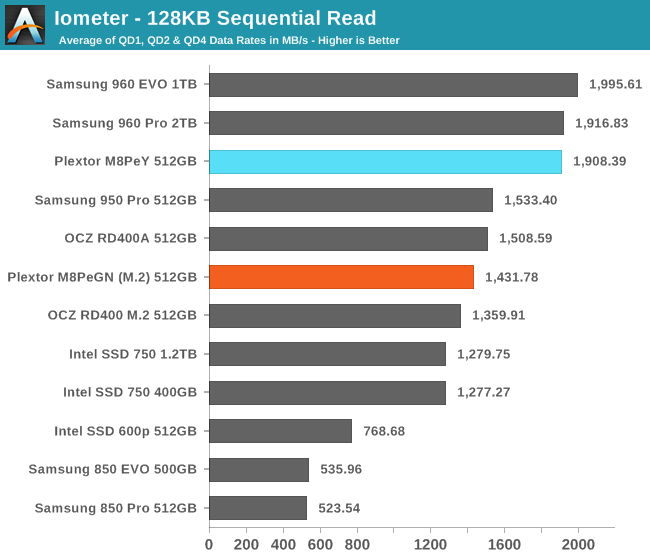
The heatsink makes a big difference for sequential read speeds: the M8PeY is essentially tied with the Samsung 960 Pro and EVO (both of which have the advantage of higher capacity). Without the heatsink, the M8PeGN delivers average performance for MLC-based PCIe SSDs.
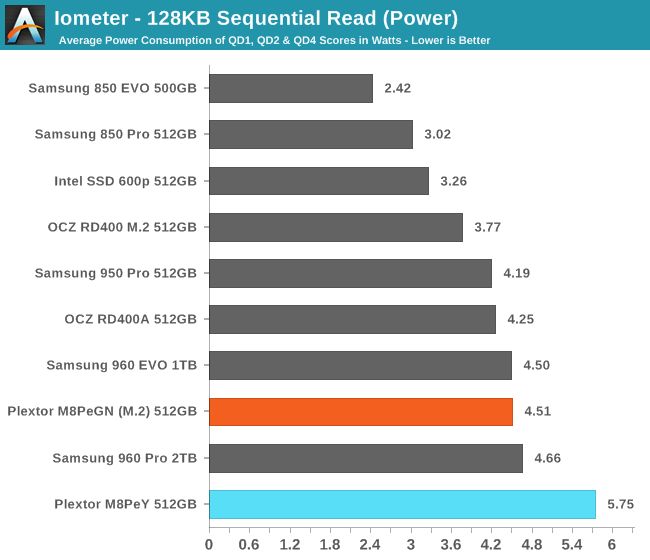
The M8PeY with its large heatsink (and LEDs) draws significantly more power than any of the M.2 PCIe SSDs to deliver top-notch performance. Without the heatsink (but with thermal throttling) the M8PeGN is still one of the most power-hungry drives. Neither configuration offers great efficiency.
 |
|||||||||
The sequential read performance of the M8Pe saturates at QD4 when the heatsink is used, but without the heatsink it is thermally limited for almost all of the test.
Sequential Write Performance
The sequential write test writes 128kB blocks and tests queue depths ranging from 1 to 32. The queue depth is doubled every three minutes, for a total test duration of 18 minutes. The test spans the entire drive, and the drive is filled before the test begins. The primary score we report is an average of performances at queue depths 1, 2 and 4, as client usage typically consists mostly of low queue depth operations.
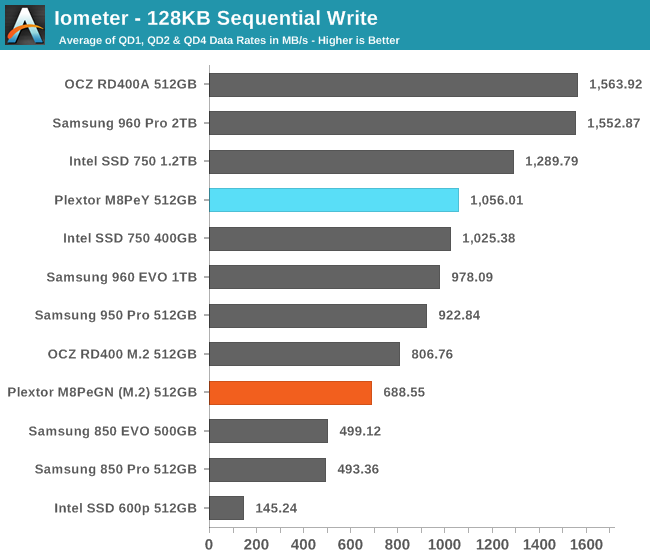
As with random writes and sequential reads, the heatsink makes a big difference for sustained sequential writes. Without the heatsink, the M8Pe's high power consumption leads to enough thermal throttling that it is the slowest MLC PCIe SSD in the bunch, but still substantially faster than SATA. With the heatsink, speeds are over 50% faster and the M8Pe is on par with the Intel SSD 750.
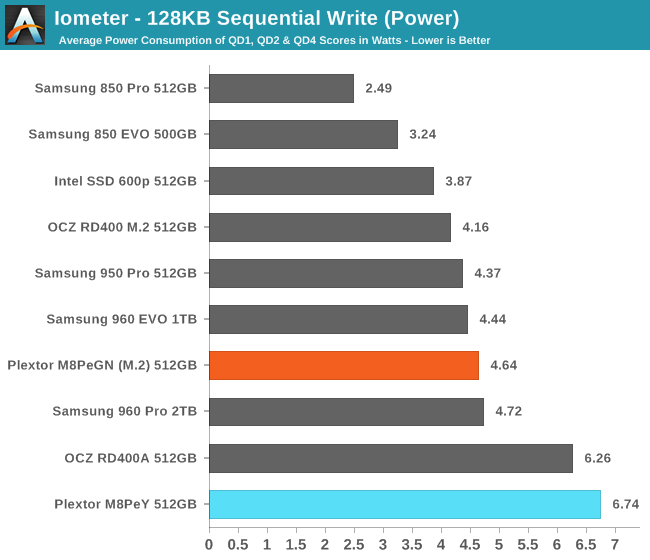
The power consumption situation is very similar to what we saw on the sequential read test. The thermally-limited M8PeGN draws a similar amount of power to the Samsung 960 Pro, while the M8PeY draws much more, and neither wins a prize for efficiency.
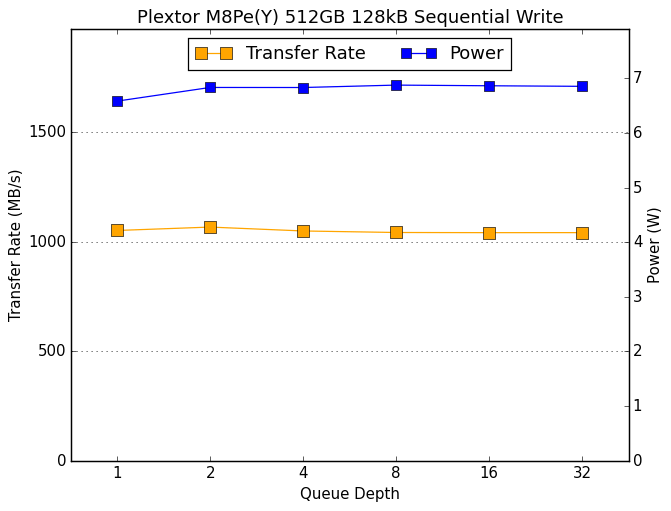 |
|||||||||
Without a heatsink, thermal throttling starts very early on this test, but the M8PeGN gets in enough of a burst at the beginning to have a noticeably better average at QD 1 than later in the test. With the heatsink, the M8PeY shows mostly flat performance across the entire duration of the test.










64 Comments
View All Comments
Magichands8 - Wednesday, December 14, 2016 - link
This is amazing! Tiny 128GB SSDs for $0.64/GB! And look at that 1TB for $0.51/GB! We even get to use a crappy Microsoft bundled driver for these! Who knows, in 2017 we may even get to see consumer SSDs reach $0.80, $0.90 or even $1+ per GB... Time doesn't stand still and neither does the endless march of progress. Brace yourselves guys, the future's going to be an amazing place.ironwing - Thursday, December 15, 2016 - link
What is a the reason that PCIe SSDs consume more power than SATA SSDs? Is it simply the higher speeds? The review covered the sleep state issues with the PCIe drives but when the drives are in a similar state, the SATA drives appear to be much more power efficient.Billy Tallis - Thursday, December 15, 2016 - link
I think the biggest problem is that the NVMe power saving states I'm testing don't include reducing the PCIe link speed or width. Keeping a PCIe 3.0 x4 link lit up takes a significant amount of power. The SATA drives by contrast are being told to put the SATA link in a low power state and take that as the signal to engage internal power saving mechanisms.bbhaag - Thursday, December 15, 2016 - link
Thanks for the great review Billy. I've been holding off on buying the Plextor for my new build hoping that Anandtech would put up a review and you guys delivered. Looks like they are solid drives at a mediocre price point. I knew I should have bought the 512 version when the egg had it for 179...sigh...oh well I can wait.DigitalFreak - Thursday, December 15, 2016 - link
$50 price difference for a heatsink? Really?Bruce427 - Friday, December 16, 2016 - link
I think that price includes a PCIe card as well.Bruce427 - Friday, December 16, 2016 - link
At first glance at published specks, it appears that the New Corsair MP500 NVMe drive may outperform the PlextorM8Pe for about the same price.Bruce427 - Friday, December 16, 2016 - link
Sorry, spell check got me. That should have been "specs."Bruce427 - Friday, December 16, 2016 - link
"specs"Billy Tallis - Friday, December 16, 2016 - link
The Corsair MP500 uses the Phison E7 controller. Next week I should have a review up of the Patriot Hellfire that is essentially the same drive. It's slower than the M8Pe on almost every test.